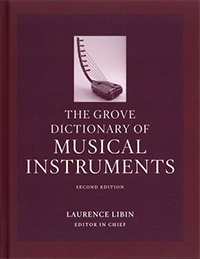MooCowMusic ... in the Dictionary
 The Grove
Dictionary of Musical Instruments is the largest, most comprehensive reference publication
on musical instruments, and forms part of the "Grove Dictionary of Music and Musicians”, first
published in 1879 and considered the primary academic reference. The Second
Edition, published in 2014, has an number of entries referencing MooCowMusic.
The Grove
Dictionary of Musical Instruments is the largest, most comprehensive reference publication
on musical instruments, and forms part of the "Grove Dictionary of Music and Musicians”, first
published in 1879 and considered the primary academic reference. The Second
Edition, published in 2014, has an number of entries referencing MooCowMusic.
Mobile phone [iPhone, Android, smartphone]
Portable electronic communication device. These have become robust platforms for digital audio production,
composition, and music performance since the beginning of the 21st century. Recent compositions for
mobile-phone ringtones might represent an emerging music genre. Since 2008, many commercial apps have
transformed mobile devices into miniature synthesizers. Popular virtual-instrument programs such as
Ocarina (2008) by the Smule Corporation and Band (2008) by MooCowMusic harness the phone’s numerous
interfaces in various ways. Multi-point touch screens offer players the ability to manipulate graphical
fingerholes, fretboards, drum pads, and keyboards, thus approximating the playing experience of acoustic
wind, string, percussion, and keyboard instruments. Beyond its use in voice recording and transmission,
a device’s microphone can register breath intensity, enabling users to initiate tones and alter dynamics
as though playing a wind instrument.
Apps [applications]
Specialized software programs that can be downloaded and run on handheld electronic devices including
tablet computers and some mobile phones. Inexpensive apps have been developed that enable host devices
to function as musical instruments (e.g. Ocarina, Pocket Guitar, Pianist, Pocket Shaker), radios (Pandora,
Sirus Jango, Tuner Internet Radio), music players (iTunes, Google Music), sound mixers (DJ Mixer Pro, Audio
Core Mixer), sequencers (Guitar Sequencer, BeatMaker), synthesizers (Moog Filtatron), effects creators,
(AmpliTube, Sonic Vox), recorders (Pro Studio), DJ Scratch tools (MixMeister Scratch), and provide
‘toolkits’ such as chord dictionaries for various instruments (ChordMaster). Apps have been supplanting
specialized devices such as mechanical and digital metronomes (iBeat) and electronic tuning aids (Cleartune).
Touch instruments [touch-sensitive instruments]
Electronic instruments that respond to the location and sometimes the degree of pressure of the user’s fingers. Touch instruments,
or touch instrument applications, are based upon software implemented on electronic visual displays, also known as touchscreens.
Touchscreens detect the position of finger or stylus contact with the display area. Examples include Bebot, a touch synthesizer first
released in 2008 by Russell Black for Normalware that features four-finger multi-touch polyphony and user-definable behaviour including
sound-generation methods, delays, and either continuous pitch changes or various discrete scales. Pitch is determined by the horizontal
position of the finger on the screen, while timbre or loudness is controlled by the vertical position. The touch instrument applications
Pianist and Guitarist introduced by MooCowMusic Ltd in 2008, function as wireless MIDI digital instrument simulators, with keyboards,
guitar necks, or tablature displayed on touchscreens that are played with the fingers.
The Grove Dictionary of Musical Instruments is available to read online here.
[Note that a subscription is required to access the online resource, but you can log in for free with a UK library card or via a recognised educational institution]
A physical copy can be purchased here.
